Research by Jaime Ortega.
Found in the north of present day Syria, Tell Qaramel dates close in age to Gobekli Tepe (Turkey) 9130–8800 BCE. Civilization that was said to had started thanks to religious ceremonies, instead of conventional agricultural, or military unification.
Tell Qaramel is a tell, or archaeological mound, located in the north of present-daySyria, 25 km north of Aleppo and about 65 km south of the Taurus mountains, adjacent to the river Quweiq.
Before the excavations began, it was assumed that permanent sedentary settlements would occur only in combination with the first farming of cereals, and the first domestication and keeping of animals such as sheep and goats, marking the start of the Neolithic period, part of a transition between the proto-Neolithic and Pre-Pottery Neolithic A cultures.
However the remains of the structures uncovered at Tell Qaramel appear to be older than this, giving the first evidence of permanent stone-built settlement without signs of animal domestication or organised farming.
Particularly striking are the remains of a succession of five round, stone-built towers, each over 6 metres in diameter, with stone walls over 1.5m thick.
These have been carbon-dated to between the eleventh millennium and 9650 BC. This dating makes the towers roughly two thousand years older than the stone tower found at Jericho, which was previously believed to be the oldest known tower structure in the world
The round towers of Qaramel have now been confirmed by 14C dating as the oldest such structures anywhere in the world.
At c. 10,650 BC after calibration, they are older than the tower known from Pre-Pottery Neolithic Jericho. The team from the Polish Centre, directed by Prof. Dr. Ryszard F. Mazurowski, had observed the feature earlier, but only now have the excavations progressed sufficiently to permit a better understanding of the towers and surrounding area.
Between April 5 and May 19, the team explored the underlying remains of three earlier towers erected successively on the same spot and differing in dimensions and wall-construction technique.




The third structure down, designated as Tower 0, was over 5m in diameter and had walls about a meter thick, made of small pebbles. It had no special foundations. The clay floor had been installed on a bedding of small pebbles. In the southeastern corner, there was a crescent-shaped bench built of stone and coated with mud, and in front of it, a round fireplace lined very carefully with the same clay used for the floor. Its bottom and sides were covered with a white lime mass. Evidence suggested that the floor and fireplace were repaired at some time during the tower’s existence. Considering the execution and the specific interior arrangement, the tower could have been more than just a defensive refuge; it may very well have served as a place of assembly and cult practices. A layer of burning 2-3cm thick preserving lumps of charcoal in and around the tower indicates that it was destroyed in a heavy conflagration.
Surprisingly, Tower 0 turned out to have been the second structure on the spot. The earliest construction was also about 5m in diameter but had walls thinner by half, only 0.50m thick. Its vestiges had been leveled to the ground in the construction of the successive Tower 0, but since it had been sunk in the ground, this part, consisting of a wall of big pebbles lining the inside of a round pit dug in the ground, has been preserved. Massive pebbles forming a kind of paving may have constituted the floor level of this construction.


Remains of regular walls of huge boulders found underlying this last Tower 01 suggest an even earlier architectural feature, which will be explored in the next season.
The neighborhood of the tower contained a number of round or oval house structures, sunken or aboveground. Round hearths in stone casings were scattered fairly regularly in the open areas between the houses. Round storage pits were also discovered. One such pit, lined with mud to protect against damp, was found filled with the skeletal remains of a whole auroch (?), obviously burned there. The earliest occupation, discovered in the southernmost trenches K-4/L-4, including a deep pit and a round house, can be dated even as early as the 12th century and attributed to the Epipaleolithic in the region.


The finds inventory complements the picture already formed of a complex and affluent community living on Tell Qaramel in the Pre-Pottery Neolithic period. Not the least is this year’s discovery of a fragmentary figurine of dried clay representing a bird. Ornamented stone arrow straighteners, showing geometric designs, naturally represented and stylized images of snakes and human figures etc. are a regular component of the finds, as are stone querns, pounders, grinders, decorated bowls, axes, picks, polishing stones, awls, needles, miniature toilet vases etc.




The Tell from the road up from Qaramel
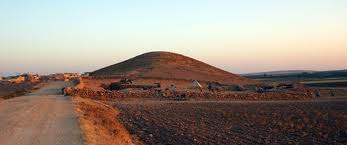
An aerial view, the excavation can be see as a long rectangle running up the slope

In the trench at Qaramel

At work from the site
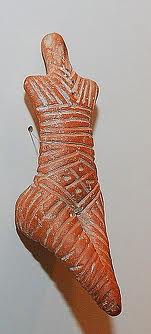
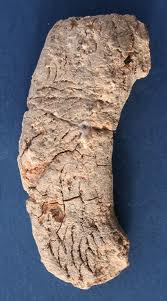

Tell Qaramel is two thousand years older than Jericho and is known as the ‘place with five towers’ . The tell has been occupied since man began to settle into villages.
Before the excavations began, it was assumed that permanent sedentary settlements would occur only in combination with the first farming of cereals, and the first domestication and keeping of animals such as sheep and goats, marking the start of the Neolithic period, part of a transition between the proto-Neolithic and Pre-Pottery Neolithic A cultures
Discussion and photos of the towers
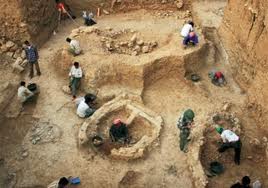
Collection of tools from the site
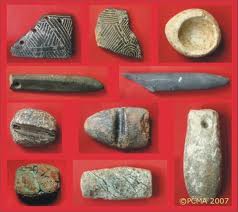
The site is best known for the remains of its towers which were built before domestication of animals and plants.
The first report on the site with photos of the site
Study of human remains found at TQ
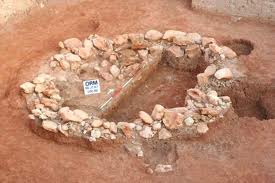
A representation of what the settlement might have looked like in its earliest stages
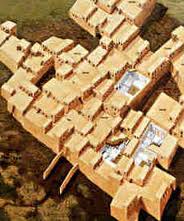
One last media report by the Polish press
In the last season, the archaeologists examined the fourth tower – and discovered a fifth one. The diameters of both are over 6 metres, and their walls are 1.5 metres thick. “In the central parts of both towers with circular bases, and with walls partly set into the ground, there are huge hearths. We also found trapezium-shaped stone benches, which lead the dwellers of the settlement to the hearth from the north-western side, as well as from the south side – two parallel rows of vertically placed large stones, which formed the passage to the hearth for a person authorised to light and keep the fire” – Prof. Mazurowski explained.
“Before, it was assumed that the Neolithic culture spread from southern Levant, among others from Jericho. Now, it turns out that there was an equally ancient culture in the north, represented in Tell Qaramel. A series of elements of this culture are even older than those found in Palestine. Thus, in the Near East, the culture of the Old World has a more polycentric origin. The research in Tell Qaramel permits us to amend many deeply rooted beliefs about the Near East region and the transfer of this cultural model to Europe” – he added


